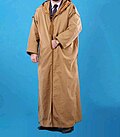Qashabiya
 Men wearing the qashabiya | |
| Material | Camel hair and wool |
|---|---|
| Place of origin | Algeria |
The qashabiya (Arabic: القشابية) is a traditional Arab winter garment originating from Algeria. It features a hood and differs from the burnous by the presence of sleeves and a closure. Thicker and wider than the Djellaba (الجلابة), it is made of camel wool. It allows its wearer to brave the wind and precipitation of winter.
It also holds significant importance in the Algerian collective memory, as it, along with the burnous, represents the attire of the shuhada during the Algerian War of National Liberation. It also has the reputation of being Algeria's national attire.
Etymology
[edit]According to Georges Séraphin Colin, the term "qeššabiya" used in central and eastern Algeria is a deformation of the Latin gausapa, a term that would have been preserved in the form of gosaba in the Adrar, where it refers to a shirt.[1]
Arabic dictionaries list several definitions and etymologies for the term qashabiya, although they all agree in designating a garment but differ in its characteristics.
Origin
[edit]
The Qashabiya, a characteristic garment symbol of the High Plateaus of Algeria, is mainly crafted in the heart of Djelfa and its surroundings. It can also be found in the eastern regions of Morocco, the Aurès, Tunisia, and even as far as Tripolitania.[citation needed]
The qashabiya is associated with the mujahideen who fought during the Algerian War of Independence. The qashabiya was crucial in helping Algerian guerrillas withstand the harsh cold in the mountains while also allowing them to blend into their surroundings for camouflage. Nowadays the region of the Ouled Nail is renowned for crafting and wearing the qashabiya.[2]
Fabrication
[edit]The Qashabiya is still made by tailors in Sétif, particularly in the district of "At Tarazoun" (الطرازون) street. This traditional industry is however threatened by lack of transmission to the youngest.[3]
In the Djelfa region, a camel wool fabric called Ouabri is made. This fabric is used in the making of a wide range of Qashabiya and Burnous Ouabri. These two garments are in high demand today, particularly the Qashabiya Ouabri. In addition, the fabric of the fabric adapts well to other garments, particularly modern outfits.[4]
See also
[edit]References
[edit]- ^ E. B (1995-11-01). "Djellaba". Encyclopédie berbère (in French) (16): 2425–2427. doi:10.4000/encyclopedieberbere.2181. ISSN 1015-7344. Retrieved 2022-12-04.
- ^ "القشابية.. القاسم الذي يجمع بين الفقراء والأثرياء في عز الشتاء". Echorouk El Yawmi. 7 January 2019. Retrieved 6 October 2024.
بأن المناطق التي تشتهر بها حاليا هي أولاد نايل بالجلفة، وبلدية مسعد على الخصوص، بعدما كانت القشابية البيضاء لسيدي خالد وأولاد جلال هي الرائدة في خمسينيات القرن الماضي، بحكم توفر المنطقة على المادة الأولية وهي الصوف.
- ^ "اللباس التقليدي للرجال يصارع البقاء بشوارع الجزائر". الجزيرة نت (in Arabic). Al jazeera. Retrieved 2024-10-06.
- ^ M. El Moujabber; H. Belhouchette; M. Belkhodja; P. Kalaïtzis; R. Cosentino; W. Occhialini. "Research and innovation as tools for sustainable agriculture, food and nutrition security : extended abstracts and papers". www.cjoint.com. Retrieved 2024-01-21.
Le produit issu de cette activité nommée étoffe est très apprécié au niveau national et même au delà des frontières. Il est utilisé dans la confection d’une grande gamme de Qashabiya et Burnous Ouabri. Ces deux habits connaissent aujourd’hui une demande importante particulièrement la Qashabiya Ouabri. En plus, le tissu de l'étoffe s'adapte bien à d'autres confections notamment des tenues modernes.
- Meguellati-Kanoun, Amel; Abdelali-Martini, Malika; Kanoun, Mohamed; Benmebarek, Abdelmadjid; Benidir, Mohamed (2013-12-17). "The potential loss of traditional know-how of qashabiya production in Djelfa, Algeria". In Malika Abdelali-Martini; Aden Aw-Hassan (eds.). Gender Research in Natural Resource Management: Building Capacities in the Middle East and North Africa. Routledge. pp. 37–55. ISBN 978-1-317-91634-5.
- Benmebarek, Abdelmadjid; Larbi Cherfaoui, Mohamed; Ouazane, H.; Abdelali-Martini, Maliki; Meguellati-Kanoun, Amel; Kanoun, Mohamed; Fodil, Souhila (2013-12-17). "Gender and Marketing of qashabiya in Djelfa (Algeria)". In Malika Abdelali-Martini; Aden Aw-Hassan (eds.). Gender Research in Natural Resource Management: Building Capacities in the Middle East and North Africa. Routledge. pp. 56–73. ISBN 978-1-317-91634-5.

